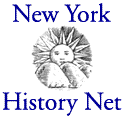|
 |
Review by J.H. Westbrook
The Island at the Center of the World:The
Epic Story of Dutch Manhattan and the Forgotten
Colony That Shaped America
Russell Shorto
Hardcover
400 pages
Doubleday
ISBN: 0385503490 |
|
Not a
historian but a writer, Shorto sets out to tell the
story of the 17th century Dutch founding of New
Netherland in middle America, of which Manhattan Island
was the fulcrum, and of the consequences that pervade to
this day. The book consists of 15 chapters grouped into
three parts, as well as a brief epilogue describing the
history of the early documents on which much of the book
is based, 26 pages of informative notes, a 21 page
bibliography covering both primary and secondary sources
that Shorto used, a couple of dozen illustrations, and
an index.
This is not the usual dry chronological history but
rather concentrates on people (both the well-known, e.g.
Hudson, Minuit, Kieft, and Stuyvesant and the important
but little-known, e.g. van der Donck, Melyn, Downing,
and Usselincx) and on the Dutch origins of enduring
concepts, familiar terms, and place names. This legacy
is especially remarkable inasmuch as the Dutch ruled the
area for only about 40 years until superseded by the
English 340 years ago. Among the terms we have: boss,
coleslaw, cookie, kill (stream), landscape, and Santa
Claus, not to mention the derogatory Dutch courage,
Dutch treat and similar others emanating from English
antipathy. Place names persisting from the Dutch period
include Yonkers, Staten Island, Rhode Island, Spuyten
Duyvil, Wall Street, and Saw Mill River.
Most significant, however, we learn from the book are
the concepts and attitudes the Dutch brought with them
early in the 17th century. In contrast to the New
Englanders the Dutch came, not as settlers or for
religious freedom, but as traders and businessmen. Other
characteristics apparent early on were the independence
of Dutch women, the Dutch concept of home, their
attitude toward children; their tidiness, and their
tolerance of different customs, religions, and origins.
From the outset, New Netherland was a cosmopolitan,
multi-ethnic society. The immigrants to the Dutch colony
were not exclusively Calvinist ethnic Dutch but
Norwegians, German Lutherans, Africans, Spanish Jews,
and French Huguenots, a reflection of the extreme
religious and ethnic tolerance that existed in 17th
century Netherlands. The cosmopolitan nature of what was
then New Amsterdam was evidenced, for example, by a 1646
report of a Jesuit priest that he found some 18
languages spoken there. From the outset, New Amsterdam,
located at the southern tip of Manhattan Island was a
lively, rowdy, busy place, made so by pirates,
prostitutes, and politicians, as well as ordinary
citizens. By the late 1640's Manhattan had become a
major shipping center and place of business.
Shorto tells an intriguing story with much insight and
wit, colorfully sketching the personalities, character
strengths, and foibles of many individuals, both those
famous, infamous, and forgotten. He gleaned the
historical facts from numerous interviews with
professional historians in Albany, New York City, Europe
and elsewhere as well as from the extensive works
referenced in his bibliography. It is also to be noted
that, in collaboration with Howard Funk, Shorto has
produced for the New Netherland project in Albany a
fascinating Internet visual, "The Virtual Tour of New
Netherland" (See: www.nnp.org).
This reviewer's interest in the book was also heightened
by the fact that Shorto mentions five of the reviewer's
ancestors.
The book has already drawn considerable critical
acclaim. It has gone into its 5th printing, with 47,000
copies now in print! It is a selection of the History
Book Club, Book of the Month Club, and Quality Paperback
Book Club.
J.H. Westbrook
Brookline Technologies
Ballston Spa, NY
Dr. Westbrook is an engineer and materials scientist
with an avid interest in history. He is the author and
editor of numerous books, journal articles, and over 100
book reviews |